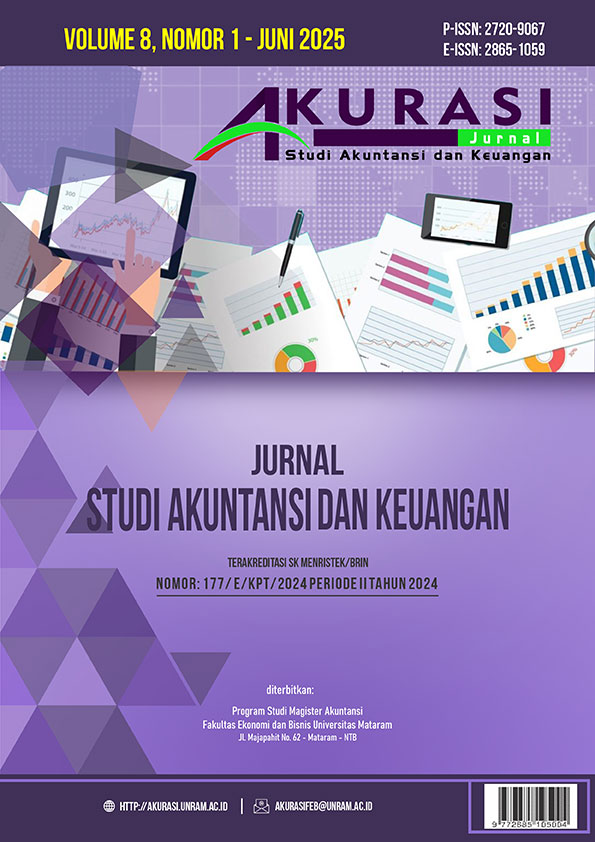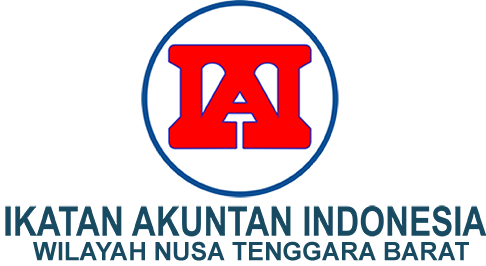EXPLORING THE ROLE OF KEY AUDIT MATTERS DISCLOSURE IN MITIGATING INVESTMENT RISK
DOI:
https://doi.org/10.29303/akurasi.v8i1.703Kata Kunci:
SA701, hal audit utama, risiko investasi, bei, laporan auditor independenAbstrak
enelitian ini mengkaji dampak pengungkapan Key Audit Matters (KAM) terhadap risiko investasi dalam konteks transparansi audit Indonesia yang terus berkembang. Penelitian ini dilatarbelakangi oleh implementasi SA701 yang mewajibkan pengungkapan KAM dalam laporan audit. Tujuan penelitian ini adalah untuk menyelidiki bagaimana berbagai aspek pengungkapan KAM memengaruhi persepsi risiko investor. Dengan menggunakan pendekatan kuantitatif, kami menganalisis data lebih dari 700.000 data terkait saham dan 1.358 observasi pada seluruh perusahaan yang terdaftar di Bursa Efek Indonesia (BEI) periode 2022-2023. Hasil analisis regresi menunjukkan bahwa pengungkapan KAM yang mendalam (KAM2) secara signifikan mengurangi risiko investasi, sementara jumlah KAM yang diungkapkan (KAM1) dan informasi moneter (KAM3) tidak menunjukkan efek signifikan. Temuan ini menegaskan pentingnya pengungkapan audit yang kontekstual dan komprehensif dalam mengurangi asimetri informasi. Penelitian ini memberikan kontribusi literatur dengan menekankan peran transparansi audit di pasar berkembang serta menyajikan rekomendasi praktis bagi regulator untuk meningkatkan standar pelaporan KAM.
Unduhan
Referensi
Abdullatif, M., Alzebdieh, R., & Ballour, S. (2023). The effect of key audit matters on the audit report lag: evidence from Jordan. Journal of Financial Reporting and Accounting, 23(1), 257–284. https://doi.org/10.1108/jfra-07-2022-0245
Adil, M., Singh, Y., & Ansari, M. S. (2021). How financial literacy moderate the association between behaviour biases and investment decision? Asian Journal of Accounting Research, 7(1), 17–30. https://doi.org/10.1108/ajar-09-2020-0086
Akerlof, G. A. (1970). The market for “lemons”: Quality uncertainty and the market mechanism. The Quarterly Journal of Economics, 84(3), 488–500. https://doi.org/10.2307/1879431
Al-Hadrami, A. H., Rafiki, A., Sarea, A., & Muhammad Dharma Tuah Putra Nasution. (2020). Is the investment decision affected by the independence and competence of the audit committee? a comparative study between Bahrain and Indonesia. Journal of Investment Compliance, 21(1), 29–48. https://doi.org/10.1108/joic-05-2020-0005
Al‐mulla, M., & Bradbury, M. E. (2021). Auditor, client, and investor consequences of the enhanced auditor’s report. International Journal of Auditing, 26(2), 134–150. https://doi.org/10.1111/ijau.12255
Alverina, G. C. A., & Hadiprajitno, P. T. B. (2022). Pengaruh profitabilitas, financial distress, ukuran perusahaan, reputasi auditor dan opini audit terhadap audit report lag. Diponegoro Journal Of Accounting 11(1), 1-13.
Asbahr, K., & Ruhnke, K. (2019). Real effects of reporting key audit matters on auditors’ judgment and choice of action. International Journal of Auditing, 23(2), 165–180. https://doi.org/10.1111/ijau.12154
Baatwah, S. R., Almoataz, E. S., Omer, W. K. H., & Aljaaidi, K. S. (2022). Does KAM disclosure make a difference in emerging markets? An investigation into audit fees and report lag. International Journal of Emerging Markets, 19(3), 798–821. https://doi.org/10.1108/ijoem-10-2021-1606
Brouwer, A., Eimers, P., & Langendijk, H. P. (2016). The relationship between key audit matters in the new auditor’s report and the risks reported in the management report and the estimates and judgments in the notes to the financial statements. Maandblad Voor Accountancy En Bedrijfseconomie, 90(12), 580–613. https://doi.org/10.5117/mab.90.31228
Genç, E. G., & Erdem, B. (2021). The analysis of the relationship between key audit matters (KAM) and firm characteristics: the case of Turkey. Emaj Emerging Markets Journal, 11(1), 60–66. https://doi.org/10.5195/emaj.2021.219
Gold, A., & Heilmann, M. (2019). The consequences of disclosing key audit matters (KAM): a review of the academic literature. Maandblad Voor Accountancy En Bedrijfseconomie, 93(1/2), 5–14. https://doi.org/10.5117/mab.93.29496
Jogiyanto. (2017). Teori portofolio dan analisis investasi (11th ed.). BPFE: Yogyakarta.
Kend, M., & Nguyen, L. A. (2022). Key audit risks and audit procedures during the initial year of the COVID-19 pandemic: an analysis of audit reports 2019-2020. Managerial Auditing Journal, 37(7), 798–818. https://doi.org/10.1108/maj-07-2021-3225
Khakhanaev, U. S.-E. (2019). The study into factors reducing investment project financing risks. Digest Finance, 24(4), 395–402. https://doi.org/10.24891/df.24.4.395
Li, X. (2015). Research on financial risk management based on var model. The Open Cybernetics & Systemics Journal, 9(1), 1849–1852. https://doi.org/10.2174/1874110x01509011849
Longyuan, S., Zhang, Y., & Chun-yu, X. (2022). Research on influencing factors of key audit matters disclosure in China. International Journal of Innovative Research and Development. https://doi.org/10.24940/ijird/2022/v11/i9/sep22010
Maani, A. A., Buraik, O., Al-Amarneh, A., & Almashaqbeh, M. (2024). The effect of the audit committee on the voluntary risk disclosure in Jordanian commercial banks: the moderating role of family ownership. https://doi.org/10.20944/preprints202408.0667.v1
Mathew, S. K. (2011). Mitigation of risks due to service provider behavior in offshore software development. Strategic Outsourcing an International Journal, 4(2), 179–200. https://doi.org/10.1108/17538291111148008
Matta, J., & Feghali, K. (2021). The impact of Key Audit Matters (KAM) on financial information quality: Evidence from Lebanon. Indonesian Management and Accounting Research, 19(2), 135–162. https://doi.org/10.25105/imar.v19i2.7328
Mukhibad, H., Nurkhin, A., & Rohman, A. (2020). Corporate governance mechanism and risk disclosure by Islamic banks in Indonesia. Banks and Bank Systems, 15(1), 1–10. https://doi.org/10.21511/bbs.15(1).2020.01
Nguyen, L. A., & Kend, M. (2021). The perceived impact of the KAM reforms on audit reports, audit quality, and auditor work practices: stakeholders’ perspectives. Managerial Auditing Journal, 36(3), 437–462. https://doi.org/10.1108/maj-10-2019-2445
Pfeiferová, D., & Kuchařová, I. (2020). Risks of collective investment undertakings in the context of global capital markets. SHS Web of Conferences, 74, 01025. https://doi.org/10.1051/shsconf/20207401025
Putri, D. T., & Nursiam, N. (2021). Ukuran kantor akuntan publik (KAP), opini auditor, financial distress, dan pergantian manajer pada auditor switching. Perspektif Akuntansi, 4(3), 277–296. https://doi.org/10.24246/persi.v4i3.p277-296
Ren, D., & Du, J. (2020). Analysis on behavior characteristics of enterprise financing investment risk data. 315–325. https://doi.org/10.1007/978-3-030-51100-5_28
Sania, W., & Ali, S. (2024). The impact of audit fee, size of public accounting firm, company size, and leverage on the communication of key audit matters (implementation of the first year of KAM adoption in independent auditors’ reports in Indonesia). Eduvest - Journal of Universal Studies, 4(10), 9547–9564. https://doi.org/10.59188/eduvest.v4i10.38822
Segal, M. (2019). Key audit matters: insight from audit experts. Meditari Accountancy Research, 27(3), 472–494. https://doi.org/10.1108/medar-06-2018-0355
Sen, P. K. (2020). Accuracy of disclosure environment and subsidies for foreign investments. Journal of Accounting Auditing & Finance, 38(1), 29–51. https://doi.org/10.1177/0148558x20962900
Septyadi, M. A., & Bwarleling, T. H. (2020). Pengaruh volume perdagangan saham, leverage, dan kebijakan dividen terhadap volatilitas harga saham. AKURASI: Jurnal Riset Akuntansi dan Keuangan, 2(3), 149–162. https://doi.org/10.36407/akurasi.v2i3.251
Setyawan, I. R. (2010). Stock split dan likuiditas saham di bei: pengujian menggunakan hipotesis likuiditas. Jurnal Akuntansi dan Keuangan Indonesia, 7(2), 124–138. https://doi.org/10.21002/jaki.2010.07
Shao, X. (2020). Research on disclosure status and influencing factors of key audit matters. Modern Economy, 11(03), 701–725. https://doi.org/10.4236/me.2020.113052
Siagian, V. (2023). Auditor’s reputation and auditor’s opinion on stock prices: Evidence from Indonesia’s main board index. The Indonesian Accounting Review, 13(2), 221–232. https://doi.org/10.14414/tiar.v13i2.3345
Sirois, L.-P., Bédard, J., & Bera, P. (2018). The informational value of key audit matters in the auditor’s report: evidence from an eye-tracking study. Accounting Horizons, 32(2), 141–162. https://doi.org/10.2308/acch-52047
Spence, M. (1973). Job market signaling. The Quarterly Journal of Economics, 87(3), 355–374. JSTOR. https://doi.org/10.2307/1882010
Syahyono, S. (2018). Effect of portfolio investment optimization risk-based and efficiency investment on investment decision. Fair Value Jurnal Ilmiah Akuntansi Dan Keuangan, 1(1), 124–131. https://doi.org/10.32670/fairvalue.v1i1.1193
Wooldridge, J. (2013). Introductory Econometrics: A Modern Approach. Cengage Learning.
Wulandari, S. (2021). Investment risk management for vanilla agribusiness development in Indonesia. E3s Web of Conferences, 232, 02022. https://doi.org/10.1051/e3sconf/202123202022
Yue, Y. (2022). Empirical study on the impact of key audit disclosure on stock price in audit reports. BCP Business & Management, 20, 519–524. https://doi.org/10.54691/bcpbm.v20i.1026
Yulianto, A. R. (2025). Key audit matter and audit report lag: A preliminary evidence from Indonesia. Journal of Emerging Economies and Islamic Research. https://doi.org/10.24191/jeeir.v13i1.4432
Zhang, L. (2020). A study of the impact of information disclosure quality on the efficiency of corporate investment—based on civil engineering listed companies. E3s Web of Conferences, 198, 03032. https://doi.org/10.1051/e3sconf/202019803032
Unduhan
Diterbitkan
Cara Mengutip
Terbitan
Bagian
Lisensi
Penulis yang menerbitkan artikelnya di Akurasi: Jurnal Studi Akuntansi dan Keuangan menyetujui ketentuan berikut:
- Penulis tetap memegang hak cipta atas artikel yang diterbitkan.
- Penulis memberikan hak publikasi pertama kepada Akurasi: Jurnal Studi Akuntansi dan Keuangan.
- Artikel dilisensikan di bawah Lisensi Creative Commons Atribusi-BerbagiSerupa 4.0 Internasional (CC BY-SA 4.0).
- Lisensi ini mengizinkan siapa pun untuk menyalin, mendistribusikan, menampilkan, dan mengadaptasi artikel untuk tujuan apa pun, termasuk komersial, selama mencantumkan kredit yang sesuai kepada penulis dan sumbernya, serta karya turunan harus didistribusikan di bawah lisensi yang sama.
- Semua artikel yang diterbitkan bersifat akses terbuka dan dapat digunakan untuk tujuan pendidikan, penelitian, dan ilmiah.
Lisensi: 
Karya ini dilisensikan di bawah Lisensi Creative Commons Atribusi-BerbagiSerupa 4.0 Internasional.







